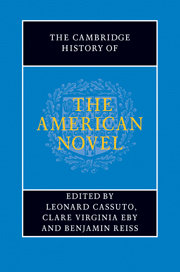Book contents
- Frontmatter
- General Introduction
- PART ONE INVENTING THE AMERICAN NOVEL
- Introduction: inventing the American novel
- 1 Transatlantic currents and the invention of the American novel
- 2 Susanna Rowson, Hannah Webster Foster, and the seduction novel in the early US
- 3 Charles Brockden Brown and the novels of the early republic
- 4 The novel in the antebellum book market
- 5 American land, American landscape, American novels
- 6 Cooper and the idea of the Indian
- 7 The nineteenth-century historical novel
- 8 Hawthorne and the aesthetics of American romance
- 9 Melville and the novel of the sea
- 10 Religion and the nineteenth-century American novel
- 11 Manhood and the early American novel
- 12 Sentimentalism
- 13 Supernatural novels
- 14 Imagining the South
- 15 Stowe, race, and the antebellum American novel
- 16 The early African American novel
- PART TWO REALISM, PROTEST, ACCOMMODATION
- PART THREE MODERNISM AND BEYOND
- PART FOUR CONTEMPORARY FORMATIONS
- A selected bibliography
- Index
14 - Imagining the South
from PART ONE - INVENTING THE AMERICAN NOVEL
Published online by Cambridge University Press: 28 July 2011
- Frontmatter
- General Introduction
- PART ONE INVENTING THE AMERICAN NOVEL
- Introduction: inventing the American novel
- 1 Transatlantic currents and the invention of the American novel
- 2 Susanna Rowson, Hannah Webster Foster, and the seduction novel in the early US
- 3 Charles Brockden Brown and the novels of the early republic
- 4 The novel in the antebellum book market
- 5 American land, American landscape, American novels
- 6 Cooper and the idea of the Indian
- 7 The nineteenth-century historical novel
- 8 Hawthorne and the aesthetics of American romance
- 9 Melville and the novel of the sea
- 10 Religion and the nineteenth-century American novel
- 11 Manhood and the early American novel
- 12 Sentimentalism
- 13 Supernatural novels
- 14 Imagining the South
- 15 Stowe, race, and the antebellum American novel
- 16 The early African American novel
- PART TWO REALISM, PROTEST, ACCOMMODATION
- PART THREE MODERNISM AND BEYOND
- PART FOUR CONTEMPORARY FORMATIONS
- A selected bibliography
- Index
Summary
“The South” as addressed in this chapter is a place of the imagination; and it is from the start a cardinal point for the broader imaginative geography of the US novel. The following pages track this South from the novels of the early republic, through the Civil War and to the rise of the more programmatic regionalist writing addressed in the second section of this volume by Tom Lutz, Barbara McCaskill, and Robert Reid-Pharr. Past studies of the South in the US novel have tended to create a sequestered subgenre – “the Southern novel” – which entails certain presuppositions about the regional (and, tacitly, racial) identity of the author of a book, as well as his or her predominant setting, worldview, and technical preoccupations. With the comparatively late development in the southern states of commercial book publishing and broad audiences for fiction, “the Southern novel” defined in this way makes a laggardly entry into US literary history; John Pendleton Kennedy's otherwise largely forgettable Swallow Barn, or a Sojourn in the Old Dominion(1832) usually is identified as the point of origin for this alternate, sub-national, tradition. Focusing a study on the regional identity of authors, though, masks the pervasiveness of the South in the broader history of the US novel. Never an isolatable term, the South is always relational, if complexly so: oppositional in its definition, delineated only against an implied “North” (or, more accurately, “nation”), the South is nonetheless intrinsic to the United States.
- Type
- Chapter
- Information
- The Cambridge History of the American Novel , pp. 236 - 251Publisher: Cambridge University PressPrint publication year: 2011



